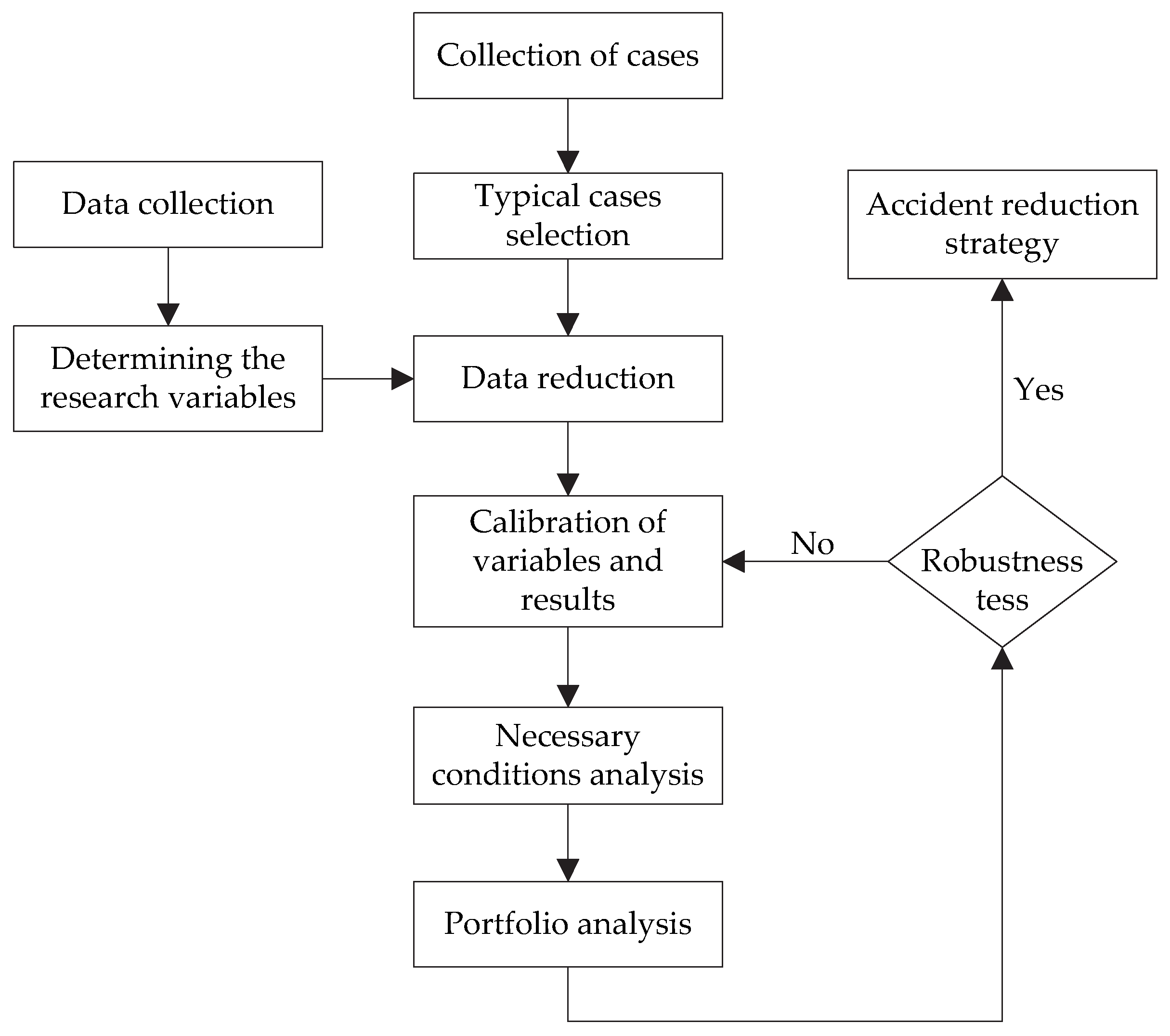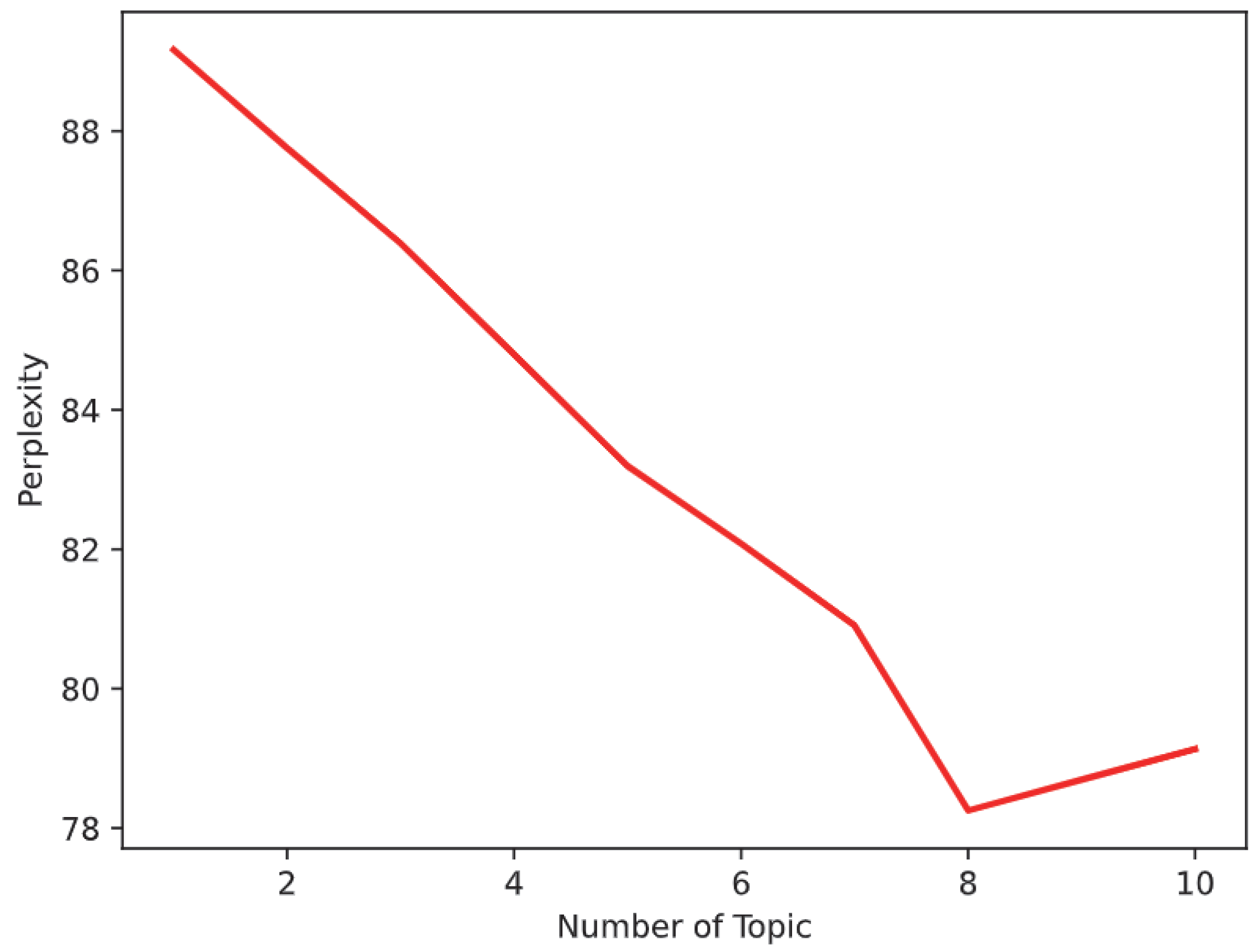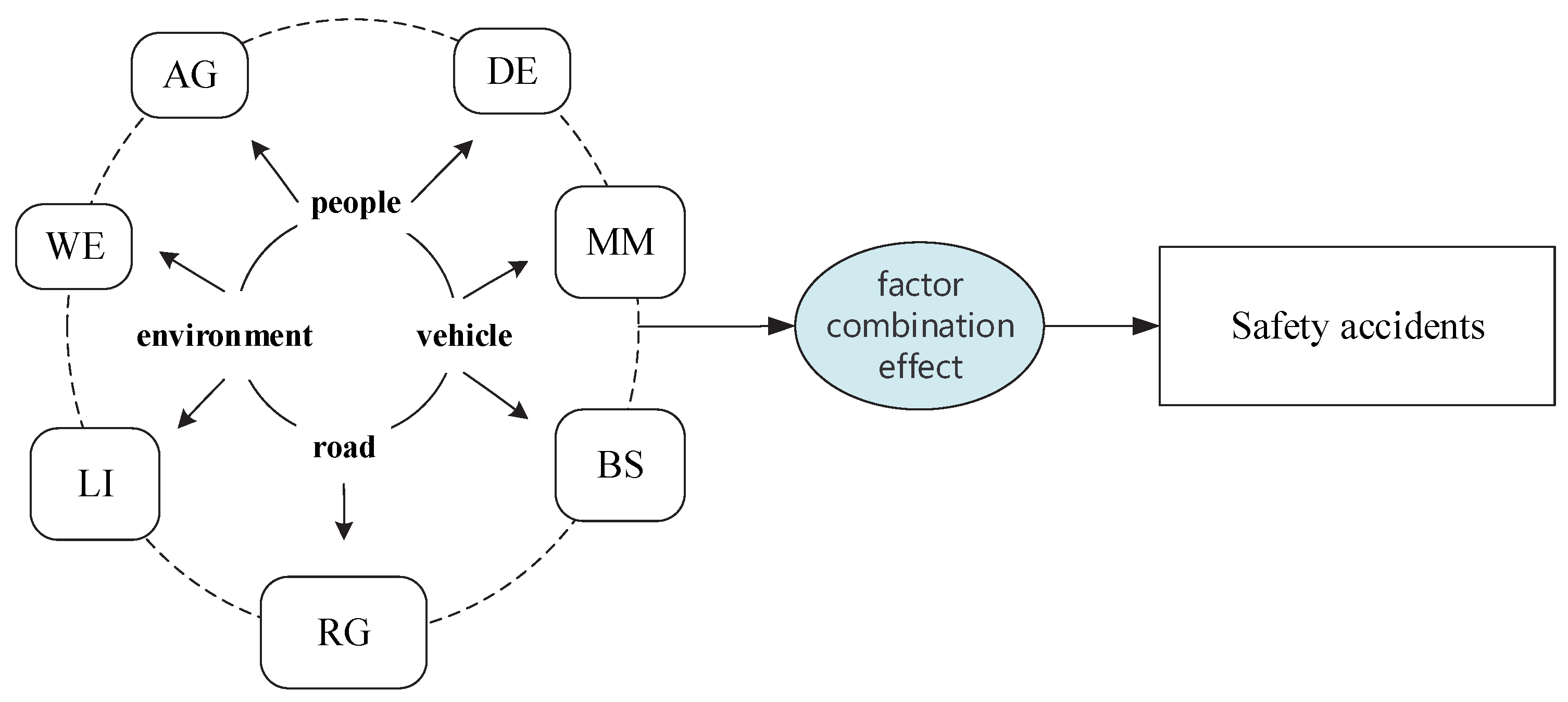Research on the Effective Reduction of Accidents on Operating Vehicles with fsQCA Method—Case Studies
Abstract
1. Introduction
2. Materials and Methods
2.1. Selection of Research Method
2.2. Case Selection for Research
- (1)
- Integrity. All selected cases have complete accident analysis reports with transparent accident processes, reasons, and complete information;
- (2)
- Representativeness. The accident case has attracted wide attention from society and has been published on the Ministry of Emergency Management website or other media, with significant influence;
- (3)
- Comparability. To ensure the external validity of conclusions, we should select cases that could be comparable; that is, there is heterogeneity among cases [31].
2.3. Variable Selection and Assignment
3. Results
3.1. Necessary Conditions Analysis
3.2. Portfolio Analysis of Influencing Factors
3.3. Robustness Test
4. Discussion
- Strengthen supervision over the self-employed.
- 2.
- Attaching importance to passenger transport safety.
- 3.
- Be aware of negligence and carelessness.
5. Conclusions
Author Contributions
Funding
Institutional Review Board Statement
Informed Consent Statement
Data Availability Statement
Acknowledgments
Conflicts of Interest
References
- Khattak, A.J.; Ahmad, N.; Wali, B.; Dumbaugh, E. A taxonomy of driving errors and violations: Evidence from the naturalistic driving study. Accid. Anal. Prev. 2020, 151, 105873. [Google Scholar] [CrossRef] [PubMed]
- Hu, J.B.; Cao, X.T. Analysis on the characteristics of drivers involved in road traffic accidents. China J. Highw. Transp. 2009, 22, 106–110. [Google Scholar]
- Pablo, L.C.; Juan, D.L.C. Age and Sex Differences in the Risk of Causing Vehicle Collisions in Spain, 1990 to 1999. Accid. Anal. Prev. 2003, 35, 261–272. [Google Scholar]
- Laapotti, S.; Keskinen, E. Differences in fatal loss-of-control accidents between young male and female drivers. Accid. Anal. Prev. 1998, 30, 435–442. [Google Scholar] [CrossRef] [PubMed]
- Paulius, M.; Vaida, V. Mathematical simulation of the correlation between the frequency of road traffic accidents and driving experience. Transport 2010, 25, 237–243. [Google Scholar]
- Qiu, L.; Nixon, W.A. Effects of adverse weather on traffic crashes: Systematic review and meta-analysis. Transp. Res. Rec. J. Transp. Res. Board 2008, 2055, 139–146. (In Chinese) [Google Scholar] [CrossRef]
- Cai, X.; Jian, J.L.; Xing, Y. Analyzing Driving Risks of Roadway Traffic under Adverse Weather Conditions: In Case of Rain Day. Procedia Soc. Behav. Sci. 2013, 96, 2563–2571. (In Chinese) [Google Scholar] [CrossRef]
- Wu, Y.; Abdel-Aty, M.; Lee, J. Crash risk analysis during fog conditions using real-time traffic data. Accid. Anal. Prev. 2017, 114, 4–11. [Google Scholar] [CrossRef]
- Xu, C.; Wang, W.; Liu, P. Identifying crash-prone traffic conditions under different weather on freeways. J. Saf. Res. 2013, 46, 135–144. [Google Scholar] [CrossRef]
- Yan, S.J.; Liu, J.H.; Yang, Z.Z.; Yan, B. Analysis of urban road traffic accident rate. Traffic Transp. 2017, 1, 215–218. (In Chinese) [Google Scholar]
- Jung, S.; Jang, K.; Yoon, Y.; Kang, S. Contributing factors to vehicle-to-vehicle crash frequency and severity under rainfall. J. Saf. Res. 2014, 50, 1–10. [Google Scholar] [CrossRef] [PubMed]
- Dhanoa, K.K.; Tiwari, G.; Manoj, M. Modeling Fatal Traffic Accident Occurrences in Small Indian Cities, Patiala, and Rajpura. Int. J. Inj. Control Saf. Promot. 2019, 26, 225–232. [Google Scholar] [CrossRef] [PubMed]
- Wang, C.; Quddus, M.; Ison, S. The effects of area-wide road speed and curvature on traffic casualties in England. J. Transp. Geogr. 2009, 17, 385–395. [Google Scholar] [CrossRef]
- Zageer, C.V. Accident Effects of Sideslope and Other Roadside Features on Two-lane Roads. Transp. Res. Rec. 1988, 1195, 33–47. [Google Scholar]
- Milton, J.C.; Shankar, V.N.; Mannering, F.L. Highway Accident Seventies and the Mixed Logit Model: An Exploratory Empirical Analysis. Accid. Anal. Prev. 2008, 40, 260–266. [Google Scholar] [CrossRef]
- Wang, J.; Huang, H. Road network safety evaluation using Bayesian hierarchical joint model. Accid. Anal. Prev. 2016, 90, 152–158. [Google Scholar] [CrossRef]
- Das, S.; Dutta, A.; Jalayer, M.; Bibeka, A.; Wu, L.T. Factors influencing the patterns of wrong-way driving crashes on freeway exit ramps and median crossovers: Exploration using ‘Eclat’ association rules to promote safety. Int. J. Transp. Sci. Technol. 2018, 7, 114–123. [Google Scholar] [CrossRef]
- Fan, S.S.; Zhang, M.J.; Qi, S.L. The relationship between abnormal driving behaviors and personality types of drivers. J. Transp. Inf. Saf. 2018, 36, 99–104. (In Chinese) [Google Scholar]
- Zahid, M.; Chen, Y.; Khan, S.; Jamal, A.; Ijaz, M.; Ahmed, T. Predicting risky and aggressive driving behavior among taxi drivers: Do spatiotemporal attributes matter? Int. J. Environ. Res. Public Health 2020, 17, 3937. [Google Scholar] [CrossRef]
- Vanlaar, W.; Simpson, H.; Mayhew, D.; Robertson, R. Fatigued and drowsy driving: A survey of attitudes, opinions and behaviors. J. Saf. Res. 2008, 39, 303–309. [Google Scholar] [CrossRef]
- Santamariña-Rubio, E.; Pérez, K.; Olabarria, M.; Novoa, A.M. Gender differences in road traffic injury rate using time travelled as a measure of exposure. Accid. Anal. Prev. 2014, 65, 1–7. [Google Scholar] [CrossRef] [PubMed]
- Kim, D.H.; Ramjan, L.M.; Mak, K.K. Prediction of vehicle crashes by drivers’ characteristics and past traffic violations in Korea using a zero-inflated negative binomial model. Traffic Inj. Prev. 2016, 17, 86–90. [Google Scholar] [CrossRef] [PubMed]
- Oppenheim, I.; Oron-Gilad, T.; Parmet, Y.; Shinar, D. Can traffic violations be traced to gender-role, sensation seeking, demographics and driving exposure? Transp. Res. Part F Traffic Psychol. Behav. 2016, 43, 387–395. [Google Scholar] [CrossRef]
- Regev, S.; Rolison, J.J.; Moutari, S. Crash risk by driver age, gender, and time of day using a new exposure methodology. J. Saf. Res. 2018, 66, 131–140. [Google Scholar] [CrossRef]
- Noh, K.H.; Rah, C.K.; Yoon, Y.S.; Yi, K.S. Experimental approach to developing human driver models considering driver’s human factors. Int. J. Automot. Technol. 2014, 15, 655–666. [Google Scholar] [CrossRef]
- Ragin, C. Redesigning Social Inquiry: Fuzzy Set and Beyond, 1st ed.; University of Chicago Press: Chicago, IL, USA, 2008; pp. 36–49. [Google Scholar]
- Sager, F.; Andereggen, C. Dealing with complex causality in realist synthesis: The promise of qualitative comparative analysis. Am. J. Eval. 2012, 33, 60–78. [Google Scholar] [CrossRef]
- Fiss, P.C. Building better causal theories: A fuzzy set approach to typologies in organization research. Acad. Manag. J. 2011, 54, 393–420. [Google Scholar] [CrossRef]
- Du, Y.Z.; Jia, L.D. Configuration Perspective and Qualitative Comparative Analysis (QCA): A New way of management research. Manag. World 2017, 6, 155–167. (In Chinese) [Google Scholar]
- Thiem, A. Beyond the facts: Limited empirical diversity and causal inference in qualitative comparative analysis. Sociol. Methods Res. 2022, 51, 527–540. [Google Scholar] [CrossRef]
- Schneider, C.Q.; Wagemann, C. Set-Theoretic Methods for the Social Sciences: A Guide to Qualitative Comparative Analysis, 1st ed.; Cambridge University Press: Cambridge, UK, 2012; pp. 58–64. [Google Scholar]
- Ma, C.S.; Chen, Y.; Zhu, W.; Ou, L. How to effectively control vertical collusion in bidding for government investment projects-Based on fsQCA method. PLoS ONE 2022, 17, e0274002. [Google Scholar] [CrossRef]
- Hudson, J.; Kuhner, S. Qualitative comparative analysis and applied public policy analysis: New applications of in novative methods. Policy Soc. 2013, 4, 279–287. [Google Scholar] [CrossRef]
- Grendstad, G. Causal complexity and party preference. Eur. J. Political Res. 2007, 46, 121–149. [Google Scholar] [CrossRef]
- Wang, Q.Q. Analysis of Influencing Factors of Traffic Accidents in Guiyang City Based on Data Mining. Master’s Thesis, Guangxi University of Science and Technology, Liuzhou, China, June 2020. (In Chinese). [Google Scholar]
- Liu, X. Research on the Correlation between Driving Age and Traffic Accidents. Master’s Thesis, Chang’an University, Xi’an, China, June 2020. (In Chinese). [Google Scholar]
- Keay, K.; Simmonds, I. The association of rainfall and other weather variables with road traffic volume in Melbourne, Australia. Accid. Anal. Prev. 2004, 37, 109–124. [Google Scholar] [CrossRef] [PubMed]
- Hauer, E. Safety Models for Urban Four-lane Undivided Road Segments. Transp. Res. Rec. J. Transp. Res. Board 2004, 1897, 96–105. [Google Scholar] [CrossRef]
- Gao, M. Analysis and Prevention of Highway Traffic Accidents in Hebei Province. Master’s Thesis, People’s Public Security University of China, Beijing, China, June 2020. (In Chinese). [Google Scholar]
- Murthy, R.K.; Madhok, A. Overcoming the early-stage conundrum of digital platform ecosystem emergence: A problem-solving perspective. J. Manag. Stud. 2021, 58, 1899–1932. [Google Scholar] [CrossRef]
- Xie, X.M.; Wang, H.W. How can open innovation ecosystem modes push product innovation forward? An fsQCA analysis. J. Bus. Res. 2020, 108, 29–41. [Google Scholar] [CrossRef]
- Ong, W.J.; Johnson, M.D. Towards a configural theory of job demands and resources. Acad. Manag. J. 2021, in press. [Google Scholar] [CrossRef]
- Greckhamer, T.; Furnari, S.; Fiss, P.C.; Aguilera, R.V. Studying Configurations with Qualitative Comparative Analysis: Best Practices in Strategy and Organization Research. Strat. Organ. 2018, 16, 482–495. [Google Scholar] [CrossRef]



| Topic | Word |
|---|---|
| 0 | prediction, model, neural network, network, method, layer, BP, value, error, degree… |
| 1 | road traffic, traffic, impact, death, number of people, vehicle, driver, accident, environment, lighting, … |
| 2 | prediction, model, road traffic, accident, impact, death, number of people, traffic, time, highway, … |
| 3 | accident, vehicle, traffic, driver, damage, system, car, operation, passenger vehicle, speed, … |
| 4 | accident, driving, death, traffic, driver, number of people, vehicle, road traffic, violation, driving experience, … |
| 5 | prediction, model, accident, road, desert, number of people, systems, traffic, a section of road, pavement, … |
| 6 | accident, death, vehicle, emergency response, driving, traffic, data, personnel, background, management, … |
| 7 | accident, driver, motorcycle, death, system, number of people, prediction, fuzzy, method, loss, … |
| Level of Accident | Explanation | Value |
|---|---|---|
| Extraordinarily serious accident | Death toll ≥ 30, number of seriously injured ≥ 100, or direct economic loss ≥ CNY 100 million; | 1 |
| Serious accident | 10 ≤ death toll < 30, 50 ≤ number of seriously injured < 100, or CNY 50 m ≤ direct economic loss < CNY 100 million | 0.67 |
| Larger accident | 3 ≤ death toll < 10, 10 ≤ number of seriously injured < 50, or CNY 10 m ≤ direct economic loss < CNY 50 m; | 0.33 |
| Ordinary accident | Death toll < 3, number of seriously injured < 10, or direct economic loss < CNY 10 m. | 0 |
| Number | DE | AG | MM | BS | RG | WE | LI | AS |
|---|---|---|---|---|---|---|---|---|
| 1 | 0 | 0 | 1 | 0 | 1 | 1 | 0 | 1 |
| 2 | 0 | 0 | 1 | 1 | 1 | 0 | 1 | 1 |
| 3 | 1 | 0 | 1 | 0 | 1 | 1 | 1 | 1 |
| 4 | 0 | 1 | 1 | 1 | 0 | 0 | 0 | 1 |
| 5 | 1 | 0 | 1 | 0 | 1 | 0 | 0 | 0 |
| 6 | 0 | 1 | 1 | 1 | 0 | 0 | 0 | 1 |
| 7 | 1 | 1 | 1 | 0 | 1 | 0 | 0 | 1 |
| 8 | 0 | 0 | 0 | 1 | 1 | 0 | 0 | 1 |
| 9 | 1 | 1 | 1 | 1 | 0 | 1 | 0 | 1 |
| 10 | 1 | 1 | 0 | 1 | 0 | 0 | 0 | 0 |
| …… | ||||||||
| Antecedent Condition | Outcome Variable | |
|---|---|---|
| Consistency | Coverage | |
| DE | 0.689594 | 0.579259 |
| ~DE | 0.543210 | 0.724706 |
| AG | 0.635802 | 0.658748 |
| ~AG | 0.690917 | 0.708729 |
| MM | 0.778660 | 0.744519 |
| ~MM | 0.585097 | 0.654339 |
| BS | 0.589065 | 0.607273 |
| ~BS | 0.410935 | 0.423636 |
| RG | 0.896825 | 0.580645 |
| ~RG | 0.292328 | 0.739130 |
| WE | 0.470899 | 0.508571 |
| ~WE | 0.529101 | 0.521739 |
| LI | 0.411199 | 0.564836 |
| ~LI | 0.719753 | 0.593837 |
| Variables | T1 | T2 | T3 | T4 | |||||||
|---|---|---|---|---|---|---|---|---|---|---|---|
| S1 | S2 | S3 | S4 | S5 | S6 | S7 | S8 | S9 | S10 | S11 | |
| DE | * | × | * | ● | * | * | × | × | × | * | |
| AG | ● | ● | ● | ⊗ | * | * | ⊗ | ⊗ | ⊗ | × | |
| MM | * | ● | ● | ● | ● | * | * | × | * | * | |
| BS | ⊗ | ● | ● | ⊗ | × | ● | ● | ● | ● | ● | |
| RG | * | ⊗ | ⊗ | ● | * | * | * | * | * | * | * |
| WE | ⊗ | × | * | ● | ● | ⊗ | ⊗ | * | × | × | * |
| LI | ⊗ | ⊗ | ⊗ | ● | ⊗ | ● | ● | * | × | * | |
| consistency | 1 | 1 | 1 | 1 | 0.992496 | 1 | 1 | 1 | 0.914141 | 0.859155 | 1 |
| Raw coverage | 0.0458554 | 0.0440917 | 0.0348324 | 0.0662698 | 0.174956 | 0.0507055 | 0.058642 | 0.0586861 | 0.159612 | 0.13179 | 0.0821429 |
| Unique coverage | 0.0458553 | 0.0185185 | 0.0282187 | 0.00886244 | 0.117725 | 0.0149912 | 0.0295414 | 0.0441358 | 0.0282628 | 0.0180776 | 0.0101852 |
| Solution consistency | 0.96141 | ||||||||||
| Solution coverage | 0.571208 | ||||||||||
Publisher’s Note: MDPI stays neutral with regard to jurisdictional claims in published maps and institutional affiliations. |
© 2022 by the authors. Licensee MDPI, Basel, Switzerland. This article is an open access article distributed under the terms and conditions of the Creative Commons Attribution (CC BY) license (https://creativecommons.org/licenses/by/4.0/).
Share and Cite
Zhang, X.; Lu, Y.; Huang, X.; Zhou, A. Research on the Effective Reduction of Accidents on Operating Vehicles with fsQCA Method—Case Studies. Appl. Sci. 2022, 12, 12737. https://doi.org/10.3390/app122412737
Zhang X, Lu Y, Huang X, Zhou A. Research on the Effective Reduction of Accidents on Operating Vehicles with fsQCA Method—Case Studies. Applied Sciences. 2022; 12(24):12737. https://doi.org/10.3390/app122412737
Chicago/Turabian StyleZhang, Xue, Yi Lu, Xianwen Huang, and Aizhao Zhou. 2022. "Research on the Effective Reduction of Accidents on Operating Vehicles with fsQCA Method—Case Studies" Applied Sciences 12, no. 24: 12737. https://doi.org/10.3390/app122412737
APA StyleZhang, X., Lu, Y., Huang, X., & Zhou, A. (2022). Research on the Effective Reduction of Accidents on Operating Vehicles with fsQCA Method—Case Studies. Applied Sciences, 12(24), 12737. https://doi.org/10.3390/app122412737







